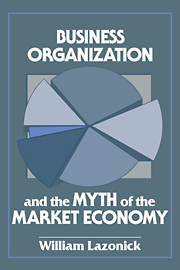Book contents
- Frontmatter
- Contents
- List of figures
- Acknowledgments
- Introduction: the wealth of three nations
- PART I Economic institutions and economic performance
- 1 Institutional foundations of industrial dominance and decline
- 2 Organizations and markets in capitalist development
- 3 Business organization and competitive advantage
- PART II Intellectual foundations and intellectual constraints
- PART III The “marvels of the market” versus the “visible hand”
- PART IV Overcoming intellectual constraints
- Index
1 - Institutional foundations of industrial dominance and decline
Published online by Cambridge University Press: 01 April 2010
- Frontmatter
- Contents
- List of figures
- Acknowledgments
- Introduction: the wealth of three nations
- PART I Economic institutions and economic performance
- 1 Institutional foundations of industrial dominance and decline
- 2 Organizations and markets in capitalist development
- 3 Business organization and competitive advantage
- PART II Intellectual foundations and intellectual constraints
- PART III The “marvels of the market” versus the “visible hand”
- PART IV Overcoming intellectual constraints
- Index
Summary
Capitalism: proprietary, managerial, and collective
What were the characteristics of the business institutions that underlay the shifts in international industrial dominance from Britain in the late nineteenth century to the United States in the early twentieth century to Japan more recently? What were the sources of economies, internal and external to business enterprises in these three nations, that formed the bases for international competitive advantage during their eras of dominance? And how and to what extent did the very different strategies and structures of business organizations that brought first Britain and then the United States to international dominance persist as impediments to organizational and technological transformation in subsequent eras when more powerful modes of business organization had appeared on the international economic scene? Drawing on a large and rapidly growing body of relevant empirical research, I shall attempt in this chapter to answer these questions.
Of necessity, the answers will be summary – succinct, but at times cryptic (particularly for the historically uninformed). My purpose here is to make the case for the growing importance of planned coordination relative to market coordination in the conduct of business activities in the most successful capitalist economies. Further elaboration and proof of the case – of the movement from proprietary to managerial to collective capitalism as the organizational foundations for industrial dominance – is a subject for ongoing research, for which the historical perspective presented here provides a general framework.
- Type
- Chapter
- Information
- Business Organization and the Myth of the Market Economy , pp. 23 - 58Publisher: Cambridge University PressPrint publication year: 1992
- 1
- Cited by



